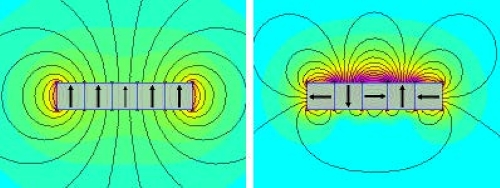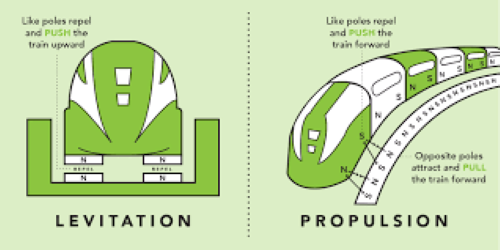
Introduction
Halbach arrays are specialized arrangements of permanent magnets that create a strong magnetic field on one side while canceling it on the other. This unique configuration, discovered by physicist Klaus Halbach, has led to a variety of innovative applications across numerous fields. This article delves into six common uses of Halbach arrays, highlighting their impact and potential.

1. Magnetic Levitation and Transportation
One of the most notable applications of Halbach arrays is in magnetic levitation (maglev) transportation systems.
Maglev trains use Halbach arrays to generate a powerful magnetic field that lifts the train off the tracks, reducing friction and allowing for smoother, faster travel. The magnetic field’s asymmetry helps stabilize the train, improving safety and efficiency. These trains, capable of reaching speeds over 300 mph, represent a leap forward in transportation technology, offering a sustainable and rapid alternative to traditional rail systems.

Related reading: Everything You Need to Know About Halbach Arrays
2. Electric Motors and Generators
Halbach arrays are instrumental in the design of more efficient electric motors and generators.
- In brushless DC motors, for instance, Halbach arrays enhance performance by creating a concentrated magnetic field that improves torque and energy conversion. This results in motors that are not only more powerful but also more energy-efficient.
- Linear motors, which produce linear rather than rotational motion, also benefit from Halbach arrays. These motors are used in applications ranging from conveyor systems to precision industrial machinery, where high efficiency and precise control are paramount.
3. Medical Imaging and Devices
In the medical field, the precision and strength of Halbach arrays are harnessed in several critical applications.
- Magnetic Resonance Imaging (MRI) machines use Halbach arrays to create strong and uniform magnetic fields. This enhances the quality of the images produced, providing clearer and more detailed scans.
- Additionally, magnetic separation devices, which are used to isolate and remove metal contaminants from medical samples, employ Halbach arrays to improve efficiency and accuracy. This technology is crucial in ensuring the purity of samples in medical diagnostics and research.
4. Particle Accelerators and Physics Research
Halbach arrays play a vital role in advanced physics research, particularly in particle accelerators. These arrays are used to focus and steer particle beams with high precision, essential for conducting experiments that probe the fundamental nature of matter.
In synchrotron light sources, Halbach arrays are integral to the operation of undulators and wigglers, devices that produce intense X-rays for scientific research. These X-rays are used to study the properties of materials at the atomic level, contributing to advancements in fields such as material science, biology, and chemistry.
5. Magnetic Refrigeration
Magnetic refrigeration is an emerging technology that promises to be more energy-efficient and environmentally friendly compared to conventional refrigeration methods. Halbach arrays are used in these systems to create the necessary magnetic fields that drive the refrigeration cycle. This technology exploits the magnetocaloric effect, where certain materials heat up when exposed to a magnetic field and cool down when the field is removed. By using Halbach arrays, magnetic refrigeration systems can achieve high efficiency and reduced environmental impact, potentially revolutionizing the cooling industry.
6. Industrial Automation and Robotics
- In industrial automation and robotics, Halbach arrays are used to achieve precision and efficiency in various tasks. Precision positioning systems, for instance, utilize Halbach arrays to create strong, focused magnetic fields that enable accurate and repeatable positioning of robotic arms and machinery. This is essential in manufacturing processes that require high precision and reliability.
- Additionally, Halbach arrays are employed in eddy current brakes, which provide smooth and controlled braking without physical contact. This technology is used in applications where precise control over deceleration is required, such as in advanced manufacturing and automation systems.
Conclusion
Halbach arrays are invaluable in a wide range of applications, from transportation and medical imaging to industrial automation and advanced research. Their ability to create strong, asymmetric magnetic fields has enabled technological advancements that improve efficiency, precision, and sustainability.
As research and development continue, the potential uses of Halbach arrays are likely to expand, driving innovation and opening new possibilities in various fields. For more information, please check Stanford Magnets.
Reference:
[1] Department of Energy (2016, June 14). How Maglev Works. Retrieved August 5, 2024, from https://www.energy.gov/articles/how-maglev-works
